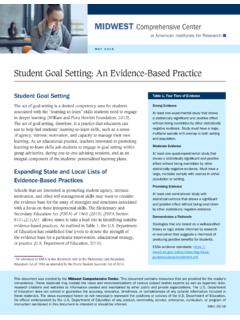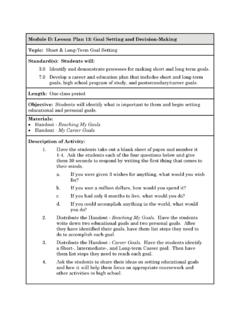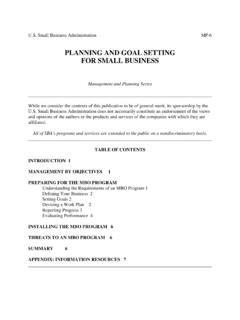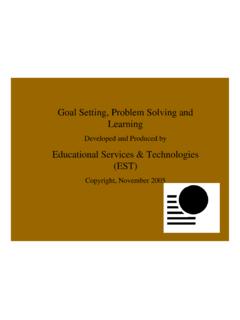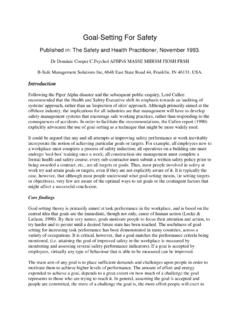Transcription of Goal Setting and Progress Monitoring
1 Goal Setting and Progress Monitoring Cathleen A. Geraghty, RTI Overview Most commonly known as an alternative method to identifying LD Direct opposition to the IQ-achievement discrepancy Wait to fail model Low achieving students Inconsistent practices More is an approach that uses students response to a high-quality instruction to guide educational decisions Efficacy of intervention/instruction Design of individual education programs Early intervention and high quality instruction Process of RTI Screening for at risk students Typically lowest 25th percentile Implement a high quality Tier 2 intervention and chart Progress If no response, move to Tier 3 intervention and continue to chart Progress Must use evidence-based, high quality interventions Benefits of RTI Early intervention Reaching students that perhaps would not have received services Improvement in overall curriculum If 50% of students are needing Tier 2 services, there may be something wrong with Tier 1 curriculum Examples of General Outcome Measures Curriculum-Based Measurement (CBM) Dynamic Indicators of Basic Early Literacy (DIBELS) CBM Developed by Stanley Deno at the University of Minnesota.
2 Was designed to be a reliable and valid measurement system for evaluating basic skills growth. There are various probes provided in the areas of reading and mathematics, some examples are: Initial Sound Fluency Letter Naming Fluency Phoneme Segmentation Fluency Reading (Oral Reading Fluency) Maze (modified Cloze) DIBELS Phonological Awareness Initial Sound Fluency Phoneme Segmentation Fluency Alphabetic Principal Nonsense Word Fluency Fluency Oral Reading Fluency Assessments for Younger Children Characteristics CBM and DIBELS are General Outcome Measures (GOM s) GOM s are routinely utilized in the world of business and medicine. Examples include height, weight, and the Dow-Jones Industrial Average GOM s Measures cumulative mastery and integrated skills (not a specific subskill) Focused on long term goals Emphasize generalizable (real-world) behaviors Benefits to Using GOM s Simple, accurate, and relatively inexpensive Sensitive to growth across instruction or interventions Independent of specific teaching methods, programs or curriculum Technically adequate Inform Instruction Have been found to predict standardized test performance with 80% accuracy!
3 !!! Using GOM s to Inform Instruction Obtain baseline data Administer the desired probe to ascertain where the student is consistently performing. o The number of trials needed is determined by the type of measure being used. Determine an acceptable level of performance Where does the student need to be performing at in order to be successful? o There are several methods for determining normative information Is there a discrepancy??? Use the data collected in comparison to the norm to determine what to do next. Support for GOM s children whose teachers employed the ongoing measurement and better than students whose teachers used conventional Monitoring methods, such as periodic teacher-made tests, informal observation, and workbook samples (Fuchs, Deno, & Mirkin, 1984).
4 Today Why is Setting goals important How are measurable and objective goals written How to chart Progress How to determine if a goal was met Why Goal Setting is Important Is the student responding to the current instruction? However; it s not just for determining eligibility ( , did the student respond to the Tier 1/ Tier 2 instruction) Student outcomes can also be improved upon, when Progress is continually monitored Fuchs, Fuchs and Hamlett, 1991 Basing Instruction on goals Setting goals will increase student achievement Making instructional decisions based on goals is even more powerful Results of Fuchs et al., 1991 Used Math CBM to monitor Progress (global indicators)
5 Teachers just monitored Progress Teacher monitored and augmented instruction based on data Status quo Students who received instruction based on his/her current achievement levels exhibited greater growth As consultants we need to help teachers chart Progress and interpret results Why Progress Monitor Not sure how the student will respond to the instruction Progress Monitoring allows us to make decisions based on the pattern of performance, rather than on one or two isolated pieces of information Student outcomes improve when performance is assessed regularly Progress Monitoring Chart Dog Goal writing Time frame, behavior, condition, criterion By May 26, 2005, Jennifer will obtain a score of 20 digits correct as measured by a 5th grade applied mathematics assessment administered for 5 minutes.
6 Expected Rate of Increase (ROI) Generally want at least 6 data points for good inference making Progress Monitoring Collect data based on severity of problem For more severe problems, collect data 2 times per week (any more than that and we see diminishing returns) Determine the length of data collection based on the intervention and the type of problem-how soon do you reasonably expect to see improvement Sample goals Reading In (#) weeks (Student name) will read (#) Words Correctly in 1 minute from randomly selected Grade (#) passages. Spelling In (#) weeks (Student name) will write (#) Correct Letter Sequences and (#) Correct Words in 2 minutes from randomly selected Grade (#) spelling lists.
7 Math Computation In (#) weeks (Student name) will write (#) Correct Digits in 2 minutes from randomly selected Grade (#) math problems. Written Expression In (#) weeks (Student name) will write (#) Total Words and (#) Correct Writing Sequences when presented with randomly selected Grade (#) story starters. Goal Setting Very important!!!! A good goal will contain the time frame (in 16 weeks), condition in which the behavior is to occur (on the ORF measure), actual behavior (Suzy will read 45 words per minute) Obtaining Baseline Data It is important to obtain baseline data so that the growth can be accurately graphed Baseline data is used to provide an accurate representation of current performance (used for both academic and behaviorally oriented issues) Determining an Acceptable Level of Performance There are several different methods of deriving normative information.
8 District norms Classroom norms Normative growth rates District Norms All children within the district are tested A normal curve is developed based on that data All children within the district can be compared to that curve. Drawbacks to District Norms The district norms may be lower than national norms The district may not be meeting standards Classroom Norms 6 children in the classroom are tested and the target student(s) is compared to those students Quick and easy method of obtaining comparison data Drawbacks to Classroom Norms All the same drawbacks as district norms May not be as reliable of an estimate based on the small sample size.
9 Normative Growth Rates The DIBELS GOM s provide norms for each of the measures. The following is an example of the Kindergarten norms. First Grade Norms Normative Growth Rates There has been some research documenting expected performance levels using CBM Grade level of materialLevelWords correct per minuteErrors per minute1-2 Frustration<40>4 Instructional40-804 or lessMastery>604 or less3-6 Frustration<70>6 Instructional70-1006 or lessMastery>1006 or lessExpected Rate of Increase ROI s are provided by AimsWeb They provide the normal growth rates for students at different parts of the school year They can be used to determine where the student should be at in a given amount of time - goal Setting ROIs On the left is the percentile rank - anything below 25% is considered at risk Three
10 Columns with Fall, Winter and Spring norms The ROIs are on the far right Drawbacks to Normative Growth Rates Removed from school level curricula levels School/district may have significantly different populations that may normative data non-applicable (not a representative sample) Goal Writing A second grade student is having comprehension difficulties Which tool would you use to measure - why? Sample Goal That same second grader has 2 correct responses on the maze and and oral reading fluency of 62 words per minute What goals should be written? Provide a sample goal Sample Goal A fourth grade student has a score of 16 digits correct on a mathematics computation task Does he need a goal?
